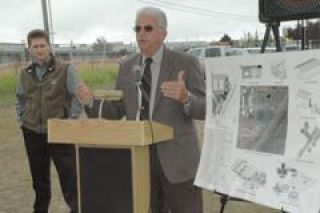By Kevin Hanson-The Courier-Herald
John Wise paused and, with a smile, said, “it's good to hear the sound of construction.”
With heavy equipment rumbling in the background, the Enumclaw mayor welcomed a small group of well-wishers to a groundbreaking ceremony for the city's wastewater treatment plant expansion project.
“It's been a 10-year adventure,” Wise said, “with a lot of complicated issues to work through.”
Enumclaw's sewage treatment woes have been well documented in recent years, as the current plant no longer meets environment standards. That has prompted a long-standing moratorium on development and annexation in town.
Work had already started on the plant expansion, but the city made it official Sept. 25 with a ceremonial turning of 20 shovels full of dirt. Taking part were were city officials and employees, representatives of firms involved in the project and other invitees.
The new portion of the treatment plant will take about a year to complete and, when finished, will satisfy demands of the state's Department of Ecology. That agency determined in the mid-1990s that outflow from the existing plant - which is dumped into the White River - was failing to meet contemporary standards.
Wise said expansion of the treatment plant is directly tied to future growth.
The mayor said he's heard from people hoping to move to Enumclaw, only to be turned off by a limited housing market.
“This will allow some families to return to Enumclaw,” he said, noting his hope that future development will include apartments, housing for senior citizens and meet the needs of other segments of the population.
In attendance was a contingent from the Enumclaw School District, and Wise noted how the plant expansion is expected to have far-reaching impacts.
“The population of our school district is going to increase,” he said, once builders are free to move forward with new housing developments.
Addressing the district's decreasing enrollment, Wise said, “we're hoping to turn that around.”
The plant expansion doesn't come without some dollars being spent, Wise reminded.
“Fees are going to be a little more expensive,” he said, referring to the costs builders incur when dealing with the city. And city ratepayers are already feeling the impact, Wise acknowledged, as monthly sewer rates have been ramped up in recent years.
The treatment plant expansion is the most expensive project in city history, with a price tag that has climbed to $26 million.
City Administrator Mark Bauer has been part of the discussion from the earliest stages, having come to the city in 1991 as its public works director.
About a month into the job, Bauer said, the roof of the sewage plant - built in 1979 - collapsed and needed repair.
It wasn't too much longer, he said, before Ecology came knocking, informing the city of troubles with the effluent it was pumping into the White River.
“I was confronted with one of the worst things you can be confronted with as a public works director,” Bauer said. It was his duty, in 1995, to suggest that the city impose a moratorium on platting and annexation.
The following years were frustrating, Bauer explained, as the DOE demanded the city improve its plant - but was unable to define what standards needed to be met.
First, Ecology needed to do a river study, which was followed by a recommendation the city could not realistically meet, Bauer said. It wasn't until 2000 that Ecology signed off on the city's proposal for improved sewage treatment.
Design studies and engineering work occupied the better part of the next four years, and then the city discovered land directly north of the current plant - where the city hoped to expand - was home to a wetland. More time passed before the city received approval to create a new wetland, replacing the one that would be destroyed.
“It's been better than a 10-year process to get us to where we are today,” Bauer said.
“It's been a long road,” agreed Chris Searcy, who replaced Bauer as public works director.
He provided the audience with a timeline, noting new construction should take about 12 months. At that time, work will begin on the existing part of the plant, renovating one portion while razing another.
Wise later said the city could look at lifting its moratorium - or the moratorium on annexation, at least - in six months. Twice a year, City Council members have to vote to continue the present moratorium, which prohibits new developments or annexation of property into the city.
New homes have been built recently, but in those cases developers had gone through the process with the city prior to implementation of the moratorium.
Kevin Hanson can be reached at khanson@courierherald.com.


